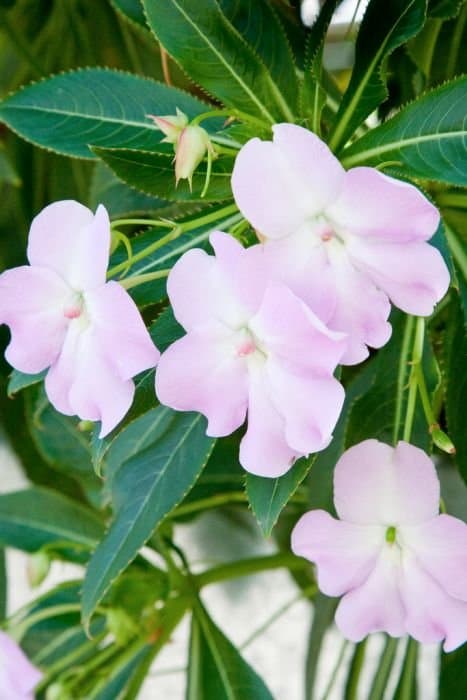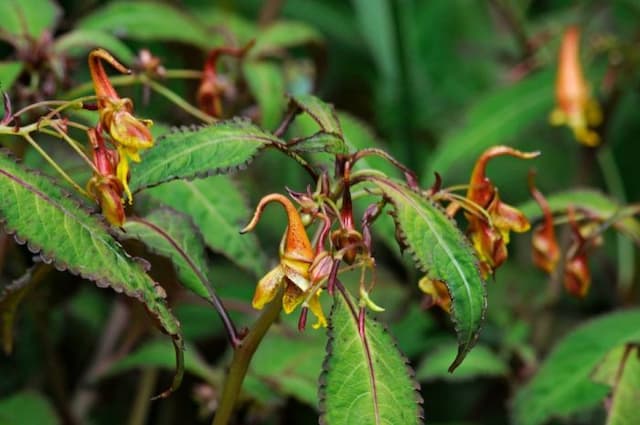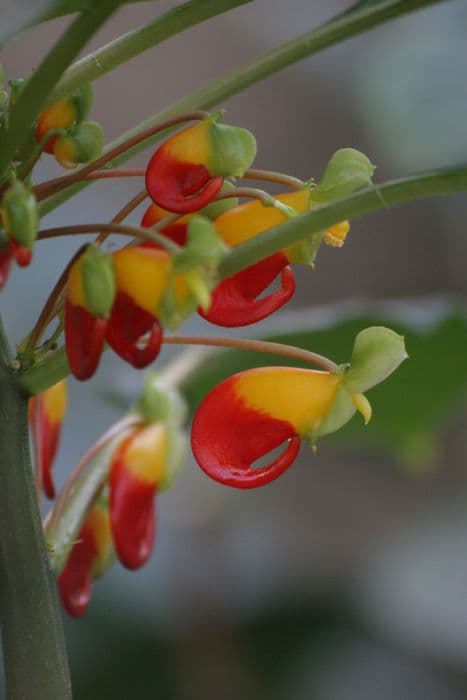Yellow Impatiens Impatiens repens

ABOUT
Impatiens repens, commonly known as the yellow impatiens, is distinguished by its striking appearance. The plant has a creeping growth habit and is often notable for its glossy, deep green leaves that provide a lush backdrop for the vibrant flowers. The foliage tends to be small and oval-shaped, with a somewhat succulent quality, which gives the plant a robust and healthy look. The flowers of the yellow impatiens are its most captivating feature. They are a bright yellow color, which can add a dash of cheerfulness to any setting in which the plant is placed. The blooms typically have a funnel-like shape and may exhibit a delicate yet eye-catching contrast with a subtle touch of red or orange at the center, adding to their overall appeal. Overall, the yellow impatiens is a showy plant known for its ornamental value, with its glossy leaves and vivid yellow flowers creating an attractive display without reference to its specific dimensions.
About this plant
 Names
NamesFamily
Balsaminaceae
Synonyms
Yellow Impatiens, Creeping Balsam, Repens
Common names
Impatiens repens
 Toxicity
ToxicityTo humans
Impatiens repens, commonly known as Yellow Impatiens, is not generally recognized as a toxic plant to humans. However, sensitivity can vary among individuals, and while it is unlikely to cause severe poisoning, ingestion of plant parts may cause minor symptoms such as stomach pain or indigestion in sensitive individuals.
To pets
Yellow Impatiens is also not known to be toxic to pets. It does not appear on lists of plants that are commonly poisonous to cats, dogs, or other domestic animals. However, as with humans, individual pets may have varying sensitivities, and accidental ingestion could potentially result in mild gastrointestinal upset.
 Characteristics
CharacteristicsLife cycle
Perennials
Foliage type
Evergreen
Color of leaves
Green
Flower color
Yellow
Height
1 foot (30 cm)
Spread
1.5 feet (45 cm)
Plant type
Creeper
Hardiness zones
10
Native area
Sri Lanka
Benefits
 General Benefits
General Benefits- Ornamental Appeal: Impatiens repens, commonly known as Yellow Impatiens, is valued for its bright yellow flowers which enhance the aesthetic appeal of gardens and landscapes.
- Low Maintenance: As a hardy plant, Yellow Impatiens requires minimal care once established, making it suitable for novice gardeners.
- Ground Cover: Its creeping habit and dense growth make it an excellent ground cover, helping to prevent soil erosion.
- Shade Tolerance: This plant thrives in shaded areas where other sun-loving plants might not grow well.
- Attracts Pollinators: The flowers of the Yellow Impatiens can attract beneficial insects such as bees, promoting pollination in the garden.
- Fast Growth: With quick growth, it can fill in garden spaces rapidly, providing lush foliage and vibrant color in a short span of time.
- Adaptability: Impatiens repens can adapt to various soil types, although it prefers well-draining, moist soil.
- Season-Long Blooms: It produces flowers throughout the growing season, offering consistent visual interest from spring to fall.
 Medical Properties
Medical Properties- There is currently no well-documented medical use of Impatiens repens in modern or traditional medicine. Therefore, no medicinal properties can be attributed to this plant as of my knowledge cutoff date in 2023.
 Air-purifying Qualities
Air-purifying QualitiesThis plant is not specifically known for air purifying qualities.
 Other Uses
Other Uses- Impatiens repens can be used in terrariums and vivariums, due to its small size and preference for moist, shaded conditions, providing a lush, green backdrop for other plants and small creatures.
- As an edging plant in shady gardens, the trailing nature and bright yellow flowers of Impatiens repens can create a beautiful border that highlights walkways and garden beds.
- In hanging baskets, Impatiens repens can be an excellent choice for creating a cascading display of greenery and yellow blooms, adding vertical interest to shaded patios or balconies.
- The plant can be involved in educational projects to teach children about plant growth and propagation, as it easily roots from cuttings, showing how new plants can grow from different parts of a parent plant.
- Impatiens repens can serve as a living mulch, covering soil with its dense foliage to help retain moisture, limit weed growth, and protect against soil erosion in shaded areas.
- Utilizing the plant in fairy gardens, its small scale and creeping habit make it an ideal addition to create a whimsical, miniature landscape suitable for shaded indoor or outdoor spots.
- The plant can play a role in butterfly gardens in shade, even though it is not specifically known to attract butterflies; its presence can complement other butterfly-attracting plants that thrive in partial shade.
- As an ornamental ground cover in shaded rockeries or shady slopes, Impatiens repens can help create a textured, colorful carpet that is both aesthetically pleasing and practical in preventing erosion.
- The plant can be used in floral crafts, where its delicate flowers and foliage can be incorporated into wreaths, flower arrangements, or pressed flower artworks.
- In aquatic garden edges, Impatiens repens can be planted where the soil remains consistently damp but is not submerged, adding a bright touch to pond surroundings or water feature borders.
Interesting Facts
 Feng Shui
Feng ShuiImpatiens repens, commonly known as yellow impatiens, can be used in Feng Shui to introduce vibrant energy and promote growth due to its bright yellow flowers. It is especially beneficial when placed in the Wealth and Prosperity area of a space, usually the southeast corner, to encourage abundance. Its lush green foliage can also help balance the Five Elements by representing the Wood element, which supports both the Fire element, reflected in the color of its flowers, and the Earth element.
 Zodiac Sign Compitability
Zodiac Sign CompitabilityImpatiens repens is not used in astrology practice.
 Plant Symbolism
Plant Symbolism- Patience: As their name suggests, impatiens symbolize patience, reflecting on the plant's ability to cope with challenging growing environments, offering a reminder to maintain composure and resilience.
- Endurance: Impatiens repens, with their capacity to spread and grow under difficult conditions, represent endurance and the ability to persist through adversity.
- Timeliness: Given their quick growing nature, impatiens are often associated with the concept of time and timely action, emphasizing the importance of seizing the moment.
- Sensitivity: Impatiens can also signify sensitivity and awareness due to their delicate structure and the plant's responsiveness to touch in some species.
 Water
WaterImpatiens, commonly known as jewelweed, prefer to be kept moist but are sensitive to overwatering. It is best to water jewelweed when the top inch of soil feels dry to the touch. Use room temperature water to gently soak the soil around the plant, ensuring you're not wetting the foliage directly to avoid potential fungal diseases. On average, this may translate to watering once every 3 to 5 days, depending on environmental conditions, but always check the soil moisture before watering. Each watering should provide enough water to saturate the soil without leaving the plant sitting in water; typically, for a potted jewelweed about half a gallon per week should suffice, although this may vary with pot size and indoor conditions.
 Light
LightJewelweed thrives in bright, indirect light or partial shade. Direct sunlight can scorch its leaves, so it's best to place jewelweed in a location that receives filtered light such as behind a sheer curtain, or in a spot that gets morning light but is shaded during the hotter part of the day. East-facing windows are often ideal spots for jewelweed, as they offer ample light without the intensity of midday sun.
 Temperature
TemperatureJewelweed is comfortable in a temperature range typical of most indoor environments. It prefers temperatures between 60-75°F and should be protected from temperatures below 50°F, as it is not frost-tolerant. The ideal temperature range encourages healthy growth, whereas exposure to temperatures outside of this range can stress the plant or potentially cause damage.
 Pruning
PruningPruning jewelweed is essential for encouraging bushier growth and preventing legginess. Trim back the stems lightly in the spring to promote more branching. Pruning can be done every few weeks during the growing season to maintain shape and size. The best time to do extensive pruning is in the late winter or early spring before new growth begins, as this helps the plant conserve energy and resources.
 Cleaning
CleaningAs needed
 Soil
SoilThe best soil mix for Creeping Balsam (Impatiens repens) should be rich in organic matter, well-draining, and maintain a slightly acidic to neutral pH between 6.0 and 7.0 to promote healthy growth.
 Repotting
RepottingCreeping Balsam should be repotted every 1-2 years or when it outgrows its current pot, ensuring the pot has good drainage to prevent root rot.
 Humidity & Misting
Humidity & MistingCreeping Balsam thrives best in high humidity conditions, ideally between 60% to 70%, which mimics its natural tropical habitat.
 Suitable locations
Suitable locationsIndoor
Grow Creeping Balsam in bright, indirect light indoors.
Outdoor
Plant Creeping Balsam in shade to partial sun outdoors.
Hardiness zone
10-11 USDA
 Life cycle
Life cycleImpatiens repens, commonly known as Yellow Creeping Balsam, starts its life cycle as a seed that germinates in moist, well-drained soil, typically in shady conditions. After germination, seedlings emerge and develop into juvenile plants, featuring the species’ characteristic yellow flowers and creeping stems that root at the nodes. As the plant matures, it reaches the flowering stage, where pollination occurs, often aided by insects attracted to its bright flowers. Following pollination, seed pods are produced, which eventually burst open in a characteristic explosive dehiscence to disperse seeds. These seeds may lie dormant until the next favorable season for germination. This cycle repeats annually, as Yellow Creeping Balsam is typically an annual or short-lived perennial, depending on the climate.
 Propogation
PropogationPropogation time
Spring-Early Summer
Impatiens repens, commonly known as creeping balsam, is easily propagated through stem cuttings, which is the most popular method. To propagate, select healthy, non-flowering stems of about 4 to 6 inches (10 to 15 centimeters) in length. Use a sharp, clean knife or scissors to take the cuttings, making a cut just below a leaf node. Remove the lower leaves to expose the nodes, as this is where new roots will form. Dip the cut end into a rooting hormone powder to stimulate root growth, although this step is optional as Impatiens repens roots quite readily. Place the cuttings in a pot filled with a well-draining potting mix, ensuring that the bare nodes are buried. Water the cuttings and cover the pot with a plastic bag to maintain high humidity, which is critical for root development. Keep the cuttings in a warm, bright place out of direct sunlight until they have rooted, typically within a few weeks. Once rooted, the new plants can be transplanted into individual pots or into the garden.
![Busy lizzie [Divine Violet]](/_next/image?url=https%3A%2F%2Fplants-admin.emdemapps.com%2Fimages%2Fplants%2F%2Fimages%2F604b651b90e59.png&w=640&q=75)



![Busy lizzie [SunPatiens Compact Orange]](/_next/image?url=https%3A%2F%2Fplants-admin.emdemapps.com%2Fimages%2Fplants%2F%2Fimages%2F604b5ef883e70.png&w=640&q=75)
![Busy lizzie [SunPatiens Vigorous Magenta]](/_next/image?url=https%3A%2F%2Fplants-admin.emdemapps.com%2Fimages%2Fplants%2F%2Fimages%2F604b622adf631.png&w=640&q=75)


![Busy lizzie [Magnum Wild Salmon]](/_next/image?url=https%3A%2F%2Fplants-admin.emdemapps.com%2Fimages%2Fplants%2F%2Fimages%2F604b589ecbd54.png&w=640&q=75)
